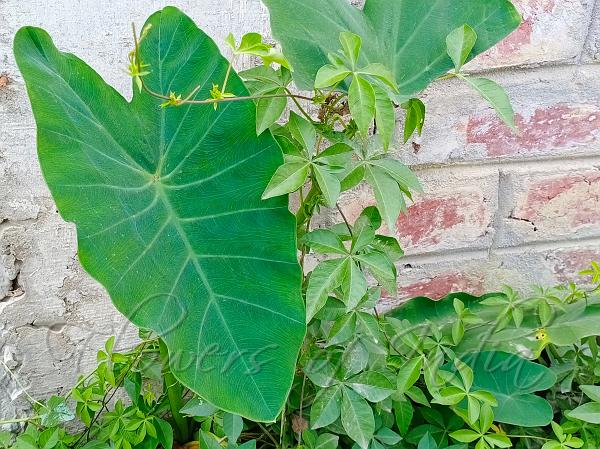|
| Deceptive Taro |
|

|

| File size | 1183064 |
| Original date | 7/28/20 4:59 PM |
| Resolution | 4608 x 2128 |
| Flash | Flash did not fire |
| Focal length | 4.05mm |
| Exposure time | 1/50s |
| Aperture | 1.78 |
| Focus Distance | |
| Metering Mode | Center weighted average |
| Camera make | vivo |
| Camera model | Y19 |
| Sensor type |
|
|
|
|
Photo: |
Botanical name: Colocasia fallax Family: Araceae (Arum family)
Synonyms: Colocasia kerrii, Colocasia tibetensis, Colocasia yunnanensis
Synonyms: Colocasia kerrii, Colocasia tibetensis, Colocasia yunnanensis
Deceptive Taro is a perennial herb, deceptively
looking like Taro. Rhizome is erect, up to 7 × 1-1.5 cm; runners 5-60
cm x up to 6 mm. Leaves are 3-8; leaf-stalk green, sometimes with
transverse purple lines, cylindric, 12-68 cm, sheathing for almost 1/2
length; leaf blade paler or slightly glaucous below, green or with dark
purple patches between primary veins above, heart-shaped-peltate,
ovate-heart-shaped, or narrowly oblong-ovate, 8-36 x 3.3-29 cm,
membranous, tip apiculate. Primary lateral veins are 5-7.
Inflorescences are 1-5 together; flower-cluster-stalk green, cylindric,
4-23 cm, slender. Spathe is constricted or not between tube and limb;
limb at anthesis orange-yellow, 5-11.2 x 2.7-4.8 cm, tip long tapering.
Spadix is stalkless, up to 6.5 cm, shorter than spathe. Berry ripens to
yellow, ovoid, about 2 mm. Deceptive Taro is found in dense forests,
humid forest margins, moist mossy rock faces in forests, valley scrub,
moist shaded places along streams, at altitudes of 700-1400 m, in
China, N Bangladesh, Bhutan, NE India, Nepal, Thailand. Flowering:
March-September.
| Identification credit: Huirem Bhabini | Photographed in Imphal, Manipur. |
• Is this flower misidentified? If yes,